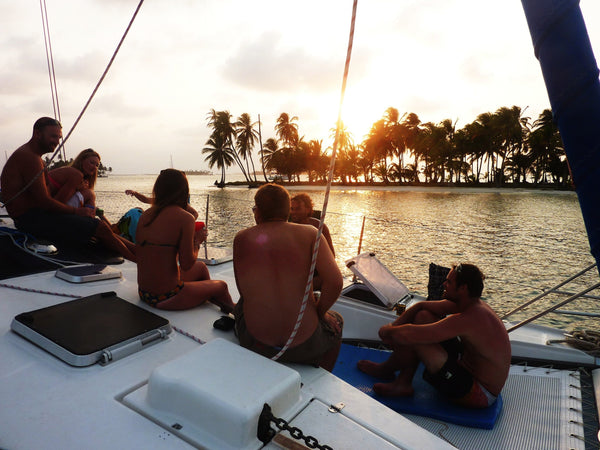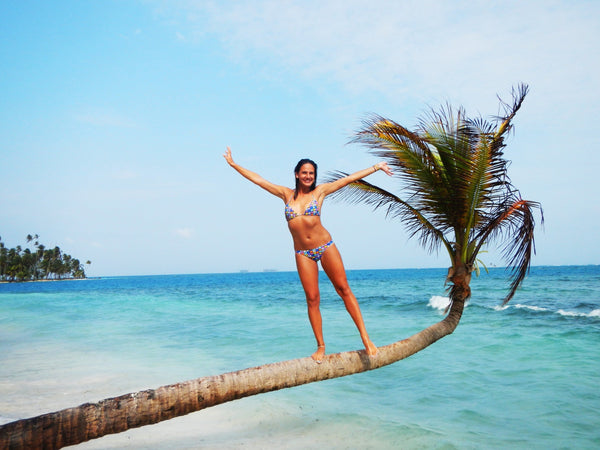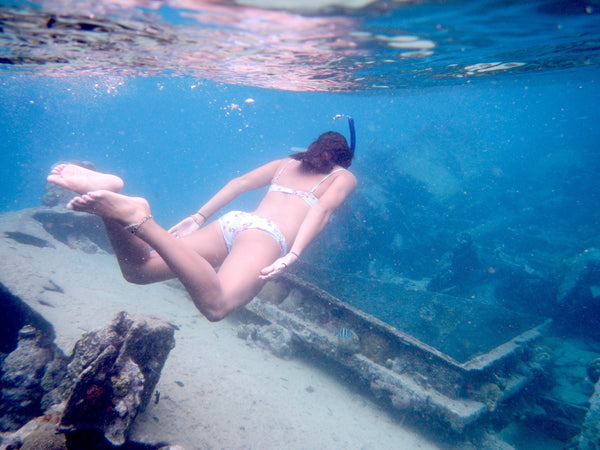They were dropping like flies. One by one, they turned green and retreated to their cabin, as the only solution for the nauseated was to lie horizontal and be still. I guess their sea legs had failed them. Not Hallie though. I watched in awe and bewilderment as the Captain’s two year old daughter roamed freely along the deck with no floatation device should she fall. She was small enough to slip through the lifeline and the waves were big enough to swallow her whole and make her disappear forever. The captain didn’t seemed phased. His tanned bare back swung from line to line, seizing the seas. His salty eyes observed the chaos on board and he laughed at Manuel hovering in the corner.
“You drank the beer. I told you not to drink the beer” he shouted. Manuel, an Austrian who was part of our boutique crew, was the first to succumb to motion sickness. He had defied Captain’s orders and drank beer out on the open ocean, contributing to his downfall. Him and Herman, his counterpart, brought an ill-advised case of beer with them. They only had five days to consume it all so they started drinking early. We also found out that Manuel complemented his beer with five empanadas.
“Sym said to have a hearty breakfast so I had four empanadas and one for lunch” he told us.
The Captain responded in his thick English accent “No, No, No. I meant eggs, toast, muesli, fruit… Not oily empanadas!”
Sym had 20 years sailing experience and knew this five-day journey well. He had advised us accordingly. His wife, Amy, was by his side as was Hallie and their 11 month old son, Maddox.
There were 11 of us all aboard Gypsy Moth, a 42ft catamaran on route to Panama from Colombia. Sailing the Caribbean from Colombia to Panama has become the predictable pathway between Central and South America. Traveling overland is essentially impossible. If you manage to escape the machine gun packing guerillas, you’ll be faced with deep unmarked rainforest trails covered in poisonous snakes and jaguars. Considering that flights cost about the same as a five-day sailing excursion, traveling by sea remains a no brainer.
Our departure from Cartagena was delayed by two days due to rough seas. We were itching to board, sights only set on the three days gallivanting through the pristine and untouched islands of the San Blas archipelago. No one had considered the two-day open ocean prerequisite.
Rough seas welcomed us. Our excitement deflated, the sound of silence left our laughter back in the protected bays of Cartagena. Our eyes fixated on the horizon, trying hard to keep our composure and not cave in.
I found my own solitary corner and observed the flying fish. They flew out of the water, their fins transforming into wings, to escape their enemies below the surface. Their survival plan was heroic yet ironic as the risk with flying seemed two fold. If the birds missed this easy bait, our catamaran certainly didn’t. The unlucky flying fish were floundering on deck. They resembled the nauseated on board who obviously weren’t made for boats either.
Through all the chaos, I watched my friend, Jess, green in the face, disappear below. She was lying in our claustrophobic cabin staring at the ceiling. As I entered, she said to me through gritted teeth; “This better be worth it”.
And it was.
32 hours later we spotted the San Blas archipelago – speckles of palm trees on the horizon. As they came further into sight, the rough seas surrendered to calm turquoise waters which slowly transitioned to a golden hue as they reflected the rays of the setting sun. Dolphins greeted us; playing, swimming and jumping around the bow of the catamaran. We anchored at our own private island for the evening and jumped into the warm waters. We swam to the island and explored it’s tiny shores of white powdered sand. We all picked coconuts, and swam back to the catamaran with them, like children showing off their sports trophies.
Sym was outraged.
“It’s illegal to steal coconuts from the islands. This is the only form of income for the Kuna Indians.”
The native Kuna Indians, a tribal society, are the only inhabitants of the islands. They live in much the same way as their ancestors and selling coconuts is one of their main sources of income.
We were all shocked and appalled to learn this. In a flurry of guilt we rid ourselves of the coconuts as quickly as we could. Nine coconuts were left bobbing in the Caribbean sea, drifting away into the sunset.


The motion of the waves still rocked my dreams. But once the sun sliced its way into our cabin and we jumped into the turquoise water for our morning shower, it was like the open ocean never happened.
We sailed to Starfish Island to BBQ freshly caught salmon for lunch. We met local Kuna Indians, who scaled the heights of the palm trees to acquire coconuts in return for money. We granted Sym a wink, proud that we were supporting the local economy this time. We carved our names in the coconuts before drinking them.

An abundance of large orange starfish lapping the surrounding shallow waters gave the island its name. We explored the perimeter, which took about 15mins. The destruction of rising waters was evident. The water was creeping gradually, consuming the sand and biting away at the roots of palm trees. Some had collapsed in despair, their prized coconuts no longer providing a living for the Kuna Indians.
“The San Blas Islands are sinking” Sym told us. “They may be gone within the next three decades”.
There are about 370 islands, and only about 45 are inhabited. The vast majority float just a few feet above sea level. According to scientists at the Smithsonian Tropical Research Institute in Panama, sea levels around the islands are rising at a rate of about three-quarters of an inch annually. At that pace, the San Blas Islands will be underwater in the next 20 to 30 years. After escaping the Spanish conquest 500 years ago from the Darien Province area, this is a sad reality for the Kuna Indians who are once again faced to move in light of their future.
We spent the next two days visiting other uninhabited islands, playing beach soccer, snorkelling through old shipwrecks, swimming, sunbathing, reading, fishing, drinking coconuts, the boys drank beer, having beach BBQs, watching sunsets, and lapping up the Caribbean warmth.



Sym farewelled us in Panama. I observed the next group board Gypsy Moth with as much excitement and eagerness as we had. Gypsy Moth floated away to do it all again, only this time in reverse – 3 days in the San Blas Islands followed by 2 days out on the open ocean. Sym swung from line to line and Hallie clambered across the deck, in control of the Caribbean at only two years old.
I turned back to our crew at the sound of a beer can opening – Manuel and Herman sat on their packs and sipped their freshly cracked beer as we waited for the bus to take us to Panama City. They had still not finished their ill-fated case of beer.
Next stop – Santa Teresa, Costa Rica.

How to choose the right boat
There are rumours of drunk captains, drug smuggling, and crews that are overbooked and overcrowded.
For this reason, it is wise to do your research and plan your trip around when a good boat is leaving rather than taking a random one that already fits into a predetermined schedule. There are many boat options:
Things to keep in mind when choosing a boat:
- Number of crew and sleeping arrangements to give an indication of crowd and comfort.
- Size and age of the boat. Bigger, newer catamarans make the open water crossing more swift and are typically equipped with showers, often hot water, and refrigerators ensuring fresh food.
- Customer reviews
Gypsy Moth is a luxury yacht. Considering they are a family boat, the above rumours are mitigated. With four double private cabins, two private singles and three bunks in the communal area, two bathrooms, and a large BBQ area, comfort is ensured.
Fast Facts
Getting there: All major Colombian carriers operate flights to and from Cartagena. There are flights to Bogotá, Cali, and Medellín. Internationally the city is connected to Miami, Fort Lauderdale and New York. Or reverse the route, starting in Panama. Airlines with international flights to Panama: American Airlines, Copa, Delta Airlines.
Price: Prices for the 5 day trip range from $475 – $550USD. Sailing at the higher end, Gypsy Moth is $550.00USD. Includes accommodation, 3 x meals / day, 3-Day San Blas Tour, transport between countries, and drinking water.
When to go: The summer/dry season in the San Blas is from December to April and means blue skies, hot days and strong winds. The seas can sometimes be rough so expect delays and pack the sea sickness tablets. The rainy season is from May through November. It rains sporadically, so is great for sailing, however keep the insect repellent handy.
I hope this provides you with some inspiration and information of adding this incredible adventure to your bucket list.
Save for planning later

























